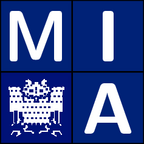(Main) Seminar: Advances in Image Processing and Computer Vision
Leif Bergerhoff, Prof. Joachim Weickert
Winter Term 2018/2019
(Main) Seminar (2 h)
Notice for bachelor/master students of mathematics: This is a »Hauptseminar« in the sense of these study programs.

Pan et al., Blind image Deblurring Using Dark Channel Prior.
NEWS:
2018/10/19: The write-up guidelines are online.
2018/10/19: The final schedule is online.
2018/07/19: The list of assigned topics is online.
2018/07/19: The slides of the introductory meeting are online.
2018/07/17: The registration period is over. There are still places left. Contact Leif Bergerhoff, if you are interested.
2018/07/16: Seminar literature and preliminary schedule are online.
2018/07/16: There are no more places left. You can still register and we put you on the waiting list (in case someone drops the seminar again). Therefore, we ask you to come to the introductory meeting, too.
2018/07/10: Registration for the seminar is open. (see below)
2018/07/09: Registration for the seminar is possible from Tuesday, July 10, 2018, 2 pm.
Important Dates – Description – Registration – Requirements – Introductory Meeting – Write-Up – Time Schedule – Literature
Introductory meeting (mandatory):
The introductory meeting will take place in building E1.7, room 4.10 on
Wednesday, July 18, 2018, 4:15 p.m..
In this meeting, we will assign the topics to the participants.
Attendance is mandatory for all participants.
Do not forget to register first (see below).
Regular meetings during the winter term 2018/2019:
Building E1.7, room 4.10 on Wednesdays, 4:15 p.m.
Contents: In this seminar, we want to discuss interesting scientific papers from the field of image processing and computer vision. We will offer a balanced mixture between recent conference or journal publications and well-known, established concepts and methods. The topics include but are not limited to image enhancement, image compression, image deblurring, optical flow, and other computer vision.
Prerequisites: The seminar is for advanced bachelor or master students in Visual Computing, Mathematics, or Computer Science. Basic mathematical knowledge (e.g. Mathematik für Informatiker I-III) is required, and some knowledge in image analysis is recommended.
Language: All papers are written in English, and English is the language of presentation.
The registration period is over.
Regular attendance: You must attend all seminar meetings, except for provable important reasons (medical certificate).
Talk:
Talk duration is 30 min, plus 15 min for discussion.
Please do not deviate from this time schedule.
You may give a presentation using a data projector,
overhead projector or blackboard, or mix these media appropriately.
Your presentation must be delivered in English. Your slides and your
write-up, too, have to be in English.
Opponent: Besides the main subject everyone gets assigned one more topic for which he or she takes over the role of an (active) opponent. This includes the preparation of meaningful questions as well as charing the session after the corresponding presentation.
Write-up: The write-up has to be handed in three weeks after the lecture period ends. The deadline is Friday, March 1, 2019, 23:59. The write-up should summarise your talk and has to consist of 5 pages per speaker. Electronic submission is preferred. File format for electronic submissions is PDF – text processor files (like .doc) are not acceptable. Do not forget to hand in your write-up: Participants who do not submit a write-up cannot obtain the certificate for the seminar.
Plagiarism: Adhere to the standards of scientific referencing and avoid plagiarism: Quotations and copied material (such as images) must be clearly marked as such, and a bibliography is required. Otherwise the seminar counts as failed.
Mandatory consultation: Talk preparation has to be presented to your seminar supervisor no later than one week before the talk is given. It is your responsibility to approach me timely and make your appointment.
No-shows: No-shows are unfair to your fellow students: Some talks are based on previous talks, and your seminar place might have prevented the participation of another student. Thus, in case you do not appear to your scheduled talk (except for reasons beyond your control), we reserve the right to exclude you from future seminars of our group.
Participation in discussions: The discussions after the presentations are a vital part of this seminar. This means that the audience (i.e. all participants) poses questions and tries to find positive and negative aspects of the proposed idea. This participation is part of your final grade.
Being in time: To avoid disturbing or interrupting the speaker, all participants have to be in the seminar room in time. Participants that turn out to be regularly late must expect a negative influence on their grade.
Please take a look at the
slides from the introductory meeting.
Among others, they contain important information for preparing a good talk.
Please make sure to consider the write-up guidelines during the preparation of your final report.
We will discuss the following research papers. If your registration was successful, the password for access will be sent to you before the first meeting.
-
S. Andris, P. Peter, and J. Weickert:
A proof-of-concept framework for PDE-based video compression.
Picture Coding Symposium, December, 2016. -
T. Brox, A. Bruhn, N. Papenberg, and J. Weickert:
High accuracy optical flow estimation based on a theory for warping.
European Conference on Computer Vision, May, 2004. -
M. Brown and D. G. Lowe:
Automatic panoramic image stitching using invariant features.
International Journal of Computer Vision, 74(1), 2007. -
J. Geiping, H. Dirks, D. Cremers, and M. Möller:
Multiframe motion coupling for video super resolution.
Energy Minimization Methods in Computer Vision and Pattern Recognition, October-November, 2017. -
J. Harel, C. Koch, and P. Perona:
Graph-based visual saliency.
Conference on Neural Information Processing Systems, December, 2006. -
B. K. P. Horn and B. G. Schunck:
Determining optical flow.
Artificial Intelligence, 17(1-3), 1981. -
D. Hafner, C. Schroers, and J. Weickert:
Introducing maximal anisotropy into second order coupling models.
German Conference on Pattern Recognition, October, 2015. -
K. He, J. Sun, and X. Tang:
Single image haze removal using dark channel prior.
IEEE Transactions on Pattern Analysis and Machine Intelligence, 33(12), 2011. -
L. Itti, C. Koch, and E. Niebur:
A model of saliency-based visual attention for rapid scene analysis.
IEEE Transactions on Pattern Analysis and Machine Intelligence, 20(11), 1998. -
M. Lindenbaum, M. Fischer, and A. M. Bruckstein:
On Gabor’s contribution to image enhancement.
Pattern Recognition, 27(1), 1994. -
D. G. Lowe:
Distinctive image features from scale-invariant keypoints.
International Journal of Computer Vision, 60(2), 2004. -
M. Nikolova and G. Steidl:
Fast hue and range preserving histogram specification: Theory and new algorithms for color image enhancement.
IEEE Transactions on Image Processing, 23(9), 2014. -
P. Perona and J. Malik:
Scale-space and edge detection using anisotropic diffusion.
IEEE Transactions on Pattern Analysis and Machine Intelligence, 12(7), 1990. -
J. Pan, D. Sun, H. Pfister, and M.-H. Yang:
Blind image deblurring using dark channel prior.
Conference on Computer Vision and Pattern Recognition, June, 2016. -
M. Stoll, D. Maurer, and A. Bruhn:
Variational large displacement optical flow without feature matches.
Energy Minimization Methods in Computer Vision and Pattern Recognition, October-November, 2017. -
T. Shibata, M. Tanaka, and M. Okutomi:
Gradient-domain image reconstruction framework with intensity-range and base-structure constraints .
Conference on Computer Vision and Pattern Recognition, June, 2016. -
M. Welk, D. Theis, T. Brox, and J. Weickert:
PDE-based deconvolution with forward-backward diffusivities and diffusion tensors.
Scale Space and PDE Methods in Computer Vision, April, 2005. -
M. Welk and J. Weickert:
An efficient and stable two-pixel scheme for 2d forward-and-backward diffusion.
Scale Space and Variational Methods in Computer Vision, June, 2017.
